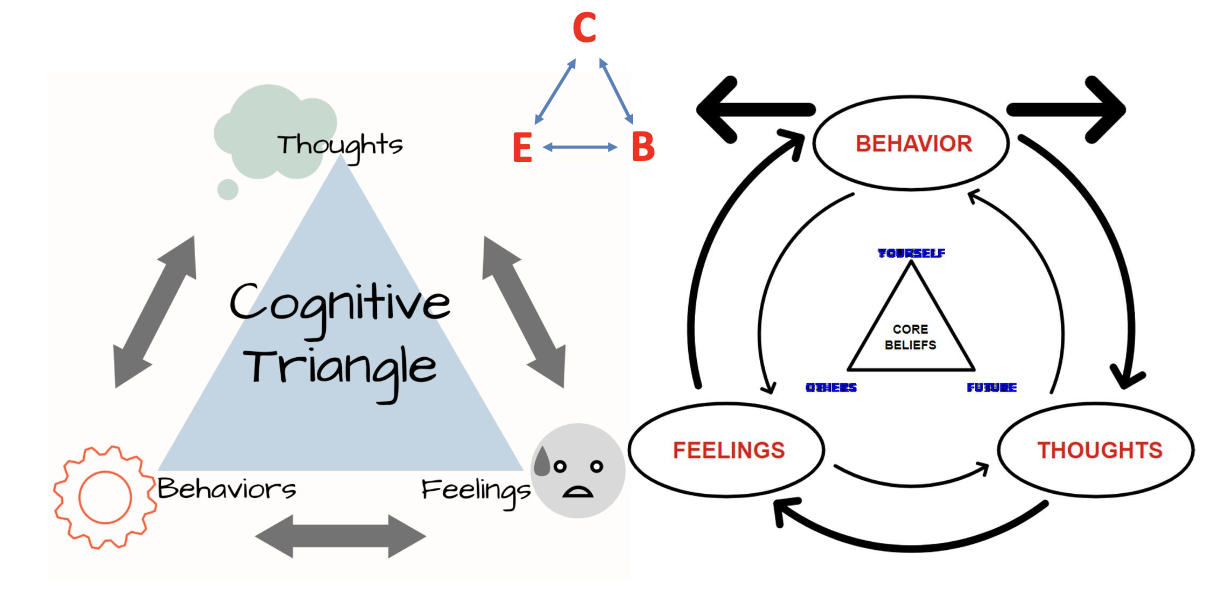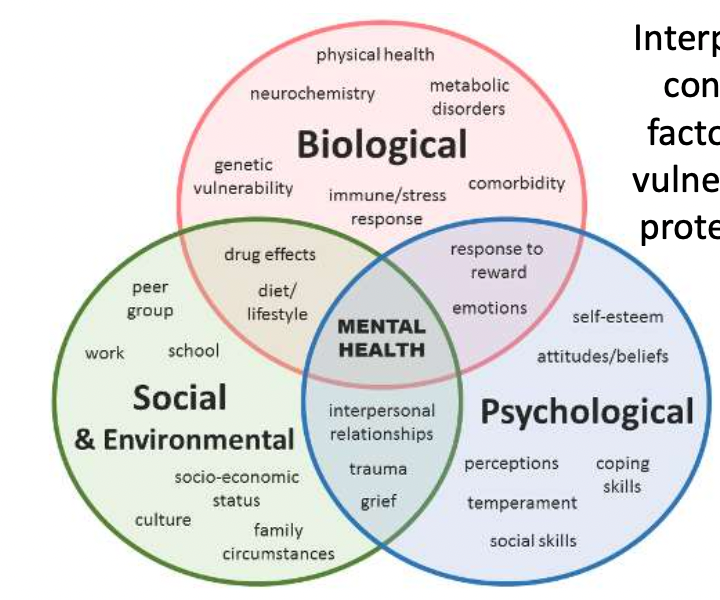Emotion & Cognition Lecture 1
1/18
There's no tags or description
Looks like no tags are added yet.
Name | Mastery | Learn | Test | Matching | Spaced |
|---|
No study sessions yet.
19 Terms
Three core theoretical models
Cognitive triangle/triad
Biopsychosocial model
The process model of emotion regulation (ER)
Cognitive Triangle/Triad

Biopsychosocial Model
Interplay between contextual risk factors, personal vulnerabilities and protective factors

Process Model of Emotion Regulation
Shaping which emotions one has, when one has them, and how one experiences or expresses these emotions
Core features of emotion regulation
Activation of a goal
Strategy: engagement to alter the emotion trajectory
Outcome: impact on emotion dynamics or modulation
Five Emotion Regulation Strategies
Situation selection
Situation modification
Attentional deployment
Cognitive change
Response modulation

Emotion Regulation in Infancy
Situational factors: situation modification
The adult may change the situation, such as taking infant out of crib
Moving away from something scary.
By facial expressions (e.g., alarmed face), vocalization, or gesture.
At a later age: situation selection when able to actively approach or avoid.
Attentional deployment
Often through distraction to make a situation less emotionally charged
By looking away, for older children or adults by focusing on other thoughts
Response modification/modulation
Changing the emotional reaction e.g. relaxing, self-soothing behaviors
Suppression of certain emotions via “display rules” → role of culture
What is an emotion?
A whole-body phenomena with connections between different processes: physiological, cognitive, behavioral
Facial expressions as indicators of underlying emotional states → inferred indicators or appraisals of emotions of others
Components of emotions:
Fysiology: arousal
Cognition: inferences/interpret
Behavior: crying, looking
Disgust: Example
Innate:
Evolutionary preparedness, like disgust to ingest either living things or their by-products (e.g. hair)
Early disgust reaction becomes extended to a much broader set of stimuli after one year of age
Learned:
Disgust in three domains: disease contamination, immoral actions, and choice of sexual partner and behaviors
Two theoretical approaches of emotions
Functionalist
Signalling/communicating
Emotions are about our own appreciation of how the event relates to our person al goals (e.g. security, food)
Differentiation
Physiological maturation
At birth: contentment, interest and distress
After 6 months: 6 basic emotions
After 18 months: more complex emotions possible
Undifferentiated vs. Differentiated
Undifferentiated: Contentment, distress, interest:
Global state of positive well-being and a negative emotional satte of “not okay”
Makes quick assessments possible
Differentiated: Basic emotions (e.g. joy, sadness):
After 6 mo. children can express 6 emotions
Understanding and showing on request develops later → dependent on cognitive development
Complex Emotions
Often combinations of basic emotions;
Thousands of possible combinations;
Develop over time, (more) dependent of opportunities from the
environment.
For instance:
Self-conscious emotions: guilt, shame, embarrassment, pride.
Moral emotions: sense of right and wrong, justice.
Complex emotions are mental representations of emotions, cognitions and behaviours.
Complex Emotions: Embarrassment
Realize that we stand out because we violated a social convention or simply are receiving unwanted attention
It is not always in reaction to negative situation such as shame
“Excessive praise can evoke embarrassment”
You start to develop it as soon as you can recognize yourself in the mirror
Moral Emotions = Complex Emotions?
Experiment helping and hindering
Some aspects of morality seem to be present at a young age, like reaction to mean and nice behavior
Concepts related to developing emotions
Recognizing emotions in others
Emotional imitation and contagion
Machiavellian emotions
Negativity bias
Recognizing emotions in others
From birth onwards: able to differentiate basic emotions in language, voice, etc.
Social referencing: use emotional reactions of others as cues to interpret ambiguous situations (e.g. scary toys, visual cliff)
Emotional Imitation and Contagion
Imitation: Making a similar facial expression, e.g. imitation just after birth
Contagion: someone feels a particular emotion and you pick it up and feel the same way, e.g. sadness, joy
Machiavellian Emotions
“End justifies the means”
Emotion meant to influence others and not simply to reflect an internal state
Often considered cold, calculating, functional
Can also be seducing, jealous, “happy”
Negativity bias
From infancy strong tendency to respond more powerfully and consistently
Larger cost to ignore or misinterpret negative emotions;
Sensitive to distress, fear in others → social referencing.
Negative Emotions: Some facts
Very difficult to distinguish between negative emotions (sadness, disgust, anger, fear) in babies.
Undifferentiated negative emotions have a strong signaling function (e.g., crying).
Babies can switch quickly between anger or sadness in the same situation, or they express ambiguous negative feelings (e.g., baby with sneezing mother).
Fear clearly expressed after 6 months (e.g., stranger anxiety).
Evolutionary preparedness to fear certain animals/situations.